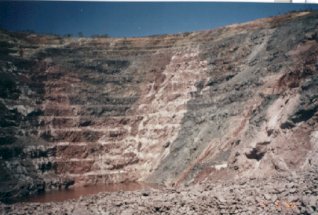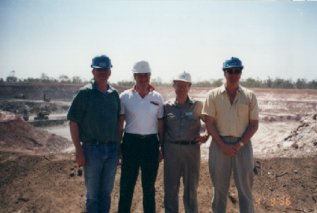Chapter 1
Contemporary Mining and Milling of Uranium in Australia
THE COMMITTEE'S INQUIRY IN CONTEXT
URANIUM MINING IN AUSTRALIA: THE FIRST PHASE
Uranium was first mined in Australia in the 1930s. Minute amounts of
radium were mined at Radium Hill in South Australia principally for medical
purposes. A small quantity of uranium ore was produced as a by-product
and used as a bright yellow pigment in glass and ceramics.
Radium Hill was recommissioned in 1954 to supply uranium oxide to the
United Kingdom-United States Combined Development Agency for seven years.
Also in the 1950s a mine and treatment plant was established at Rum Jungle,
likewise to supply uranium oxide concentrate to the UK-USA Combined Development
Authority. Another deposit was mined at Rum Jungle Creek South. Some of
the uranium oxide mined at Rum Jungle was not sold at the time. It became
the so-called Commonwealth stockpile, eventually sold in 1995.
In 1956 mining of uranium commenced at Mary Kathleen in North Queensland
near Mt Isa for the purpose of supplying contracts signed with the United
Kingdom Atomic Energy Authority. The mine was placed on a care and maintenance
basis in 1963. It was recommissioned in 1974 to supply contracts with
utilities in Japan, Germany and the United States.
In the late 1950s and early 1960s a number of small mines also operated
in the South Alligator valley in the Northern Territory, supplying contracts
to the US and UK atomic energy organisations.
These mining operations essentially constitute the first phrase of uranium
mining in Australia.
The products of this period were mainly utilised in the defence programs
of the era, but also and for the generation of electricity and small amounts
for medical purposes.
The table opposite contains a range of basic information about the mines
of this period.

Ranger: Orebody #1 - the Pit
Production from Mines Operating During Australia's Earlier Period
of Uranium Mining.
| Mine |
Proprietor |
Period |
Ore Milled
(tonnes)
|
Uranium Oxide
(%)
|
Uranium Oxide Production
(tonnes)
|
Purpose |
| Radium Hill |
South Australian Government |
1954-62 |
970 000 |
0.11-0.15 |
850 |
Combined Development Authority (i) |
| Rum Jungle |
Commonwealth funded,
managed by Territory Enterprises Pty Ltd
|
1954-71 |
863 000 |
0.28-0.41 |
3 530 |
1953-1962 - Combined Development Authority (contract
specified for defence purposes only)
1963-1971 - Commonwealth Stockplile (ii)
|
| Mary Kathleen |
Mary Kathleen Uranium Ltd |
1958-63 |
2 900 000 |
0.15 |
4 080 |
United Kingdom Atomic Energy Authority |
| Mary Kathleen (2) |
Mary Kathleen Uranium Ltd |
1975-82 |
6 300 000 |
0.10 |
4 802 |
Japan, Germany, USA for electrical power generation |
| Moline (Mill Only) |
United Uranium NL (iii) |
1959-64 |
128 000 |
0.35-0.68 |
520 |
United Kingdom Atomic Energy Authority |
| Rockhole |
South Alligator Uranium NL |
1959-62 |
13 500 |
1.12 |
138 |
United Kingdom Atomic Energy Authority |
Notes:
(i) - The Combined Development Authority (CDA) was an American and
British uranium procurement body.
(ii) - The stockpile of some 2053 tonnes of yellowcake, which was stored
at Lucas Heights, Sydney, was sold in 1993-94 and 1994-95 for electricity
production in nuclear power stations in North America.
(iii) - United Uranium NL had a contract with the US Atomic Energy
Commission to supply 200 tonnes of pitchblende ore and concentrate from
the El Sharana mine. Some 150 tonnes of pitchblende concentrate was
produced in 1956-57 and supplied through the CDA.
Sources:
Uranium Information Centre, Submission No 62.
Cawte, A. Atomic Australia 1944-1990, University of NSW Press,
1992.
AAEC, Uranium in Australia, A Collection of Articles on the History
and Development of the Uranium Mining Industry, 1962.
Senate Hansard, 28 August 1995, 515.
The mine sites continue to be a matter of active governmental and community
interest in ensuring achievement of satisfactory standards of safety,
environmental protection and rehabilitation, and removal of any potential
dangers and hazards.
URANIUM MINING IN AUSTRALIA: THE SECOND PHASE AND BEYOND
What may now be regarded as the second phase of uranium mining in Australia
commenced in the 1970s with discovery of significant deposits at Nabarlek,
Jabiluka, Ranger and Koongarra in or near the Alligator Rivers region
of the Northern Territory and at Olympic Dam in South Australia shortly
afterwards. Three of these mines commenced production between the late
1970s and the late 1980s. Other possible development in the Alligator
Rivers region and elsewhere did not proceed because of what became known
as the "three mines policy" of the Hawke-Keating Labor governments,
1983-96.
One of these three mines, Nabarlek, has since been de-commissioned. It
is the first uranium mine in Australia to be rehabilitated according to
contemporary principles and practices. (The rehabilitation continues to
be monitored.)
The other mines, Ranger and WMC's Olympic Dam Operation (ODO), are now
entering new stages of development. Orebody #1 at Ranger has been exhausted.
Mining of Orebody #3 was approved in May 1996 and mining has commenced.
Energy Resources of Australia (ERA), proprietors of Ranger, are currently
seeking approval to develop the Jabiluka lease which they purchased from
Pancontinental in 1991.
During 1996 WMC announced a massive expansion of the Olympic Dam Operation
which will virtually double the size of what is already one of the largest
mines in the world.
Ranger, and Jabiluka, if it proceeds, are uranium mines only. The Olympic
Dam Operation is predominantly a copper mine. Only approximately 20 per
cent of its production is uranium, but uranium contributes very substantially
to the financial viability of the mine.
Other possible new mines whose development is advancing actively are
at Kintyre in Western Australia and Beverley in South Australia.
Kintyre is owned by Canning Resources, a wholly owned subsidiary of RTZ-CRA.
Production is expected to commence during 1999.
Beverley is owned by Heathgate, a subsidiary of General Atomics. Production
is expected to begin in 2000.
Information provided by the Department of Primary Industries and Energy
on identified undeveloped uranium deposits in Australia is set out on
page 6.

Ranger: Orebody #3 - the Pit
L to R: Senator Macdonald, Senator Chapman, Mr Ken Lonie
(General Manager, Operations, Ranger), Senator Bishop
| PROJECT |
STATE |
OWNER |
EST.
RESOURCES U308 (tonnes)
|
TYPE OF OPERATION |
| Jabiluka (North Ranger) |
NT |
Energy Resources of Australia (100%) |
122,091 |
Underground |
| Yeelirrie |
WA |
Western Mining Corporation (100%) |
52,500 |
Open cut |
| Kintyre |
WA |
CRA (100%) |
36,000 |
Open cut |
| Koongarra |
NT |
Cogema (France) (100%) |
13,300 |
Open cut |
| Lake Way |
WA |
Asarco Australia Ltd (100%) |
3,750 |
Open cut |
| Beverley |
SA |
General Atomics (USA) (100%) |
16,200 |
In-situ leaching* |
| Honeymoon |
SA |
Mount Isa Mines (100%) |
3,360 |
In-situ leaching |
| Ben Lomond |
QLD |
Cogema (France) (100%) |
4,758 |
Open Cut (70%)
Underground (30%)
|
| Manyingee |
WA |
Cogema (France) (100%) |
4,000 |
In-situ leaching |
| Mulga Rock |
WA |
PNC Exploration
(Japanese Power Reactor & Nuclear Fuel Development Corp)
|
15,330 |
In-situ leaching |
| Bigrlyi |
NT |
Samantha Mining (42%)
Central Pacific Minerals (17%)
Yuendumu Mining (36%)
Southern Cross Exploration (5%)
|
2,667 |
Not available |
| Westmoreland |
QLD |
CRA Exploration (majority holding)
Queensland Mines (minor)
Urangessellschaft Australia (minor)
|
7,237 |
Heap leaching |
Sources: Department of Primary Industries and Energy, Submission No 91,
July 1996, Attachment B.
Daniel Stubbs and Paul Graham, "Australia in Future Uranium Markets",
ABARE Conference Paper 97.6, 24 February 1997
* For an explanation of in-situ leaching provided to the Committee by
the proprietors of the proposed Beverley mine, see Appendix 1.1.